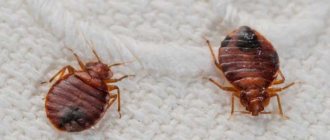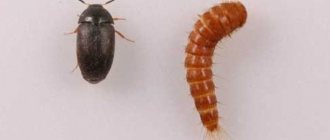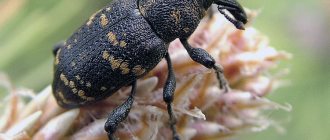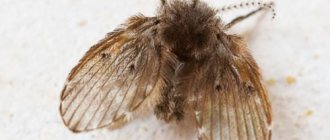Apartment owners are familiar with many insects that cause damage to food and property.
Information about the skin beetle in the apartment is divided into chapters:
- Appearance of the skin beetle
- Photo of the skin beetle
- Skin beetle lifestyle
- Harm from the leather beetle insect
- Reasons for the appearance of skin beetles in an apartment
- Carpet beetle larvae
- Skin beetle bites
- Photos of skin beetle bites
- What to do after a skin beetle bite?
- What you need to know about the skin beetle?
The leather beetle rarely appears indoors. But if he is noticed, it means that he has been living in the home for a long time and has managed to reproduce.
Appearance of the skin beetle
The insect is considered one of the smallest. The length of its body is 1.3-12 mm. It is quite difficult to detect. The skin beetle has a brown, strong shell of a round or oval shape.
It can also be dark or reddish in color. Small stripes are noticeable on the shell, slightly different in color. This shell is great for camouflage. The body is strewn with villi, with a long tuft in the shape of a tail.
Photo of the skin beetle
Preventive measures
If you have managed to get rid of these small household pests, it is also worth taking some measures to ensure that they do not appear in your home again.
- Do wet cleaning in your home as often as possible, preferably using a household steam generator.
- On the shelves of cabinets and bedside tables, place sprigs of dry lavender, wormwood or moth repellent - skin beetles do not like them either.
- Install mosquito nets on the windows and balcony - in the summer, beetles often enter the room through the window.
- Inspect your closets more often - get rid of old and unnecessary things without regret. Less clutter means fewer bugs.
- During preventive treatment of the premises with insecticides, do not forget to take care of your personal safety - wear a disposable gown, gloves, goggles and a respirator.
And remember, the appearance of any insects in the house is easier to prevent than to eliminate, so keep your home clean, and then no insects will be afraid of it.
Skin beetle lifestyle
In May, a new generation of pests appears. At this time, the females begin to mate and lay eggs. Female insects leave behind large offspring. During their life they lay over 4,100 larvae. To do this, they look for secluded places with food supplies. They mostly choose rooms that are poorly ventilated.
It can be:
But in the process of obtaining food, they can also get into a person’s home.
Adults practically do no harm to humans. For the most part, their main source of nutrition is plant sap. Voracious insects love warmth. They prefer dry places with dim lighting.
Kozheed beetle: species specifics, lifestyle
One of the smallest and yet most common pests in the home are leather beetles. The average body length of insects is from 1.3 to 12 mm, the shape is oval or almost round, the shell covers are covered with small hairs. The dark brown or black color of the shell allows insects to remain unnoticed on dark surfaces, in secluded places under furniture.
Kozher beetle
Covered with many long hairs, the larvae have a spindle-shaped body; sometimes a particularly large tuft of hair forms a kind of brush-tail.
The development of a new generation of insects begins in May after the beetles mate. In the same month, females lay eggs, taking care of their future offspring; they lay them in places where the larva will find a sufficient amount of food, which it needs for growth and development. It is interesting that adult individuals feed mainly on plant sap, but the larva, which must survive 5-6 molts before becoming an adult, needs a different diet - dry substances of plant or animal origin. Woolen carpets (there is a special type of carpet beetle), zoological and plant collections that are poorly cared for, as well as dry food supplies can be excellent food for the larvae.
Harm from the leather beetle insect
As the name suggests, the leather beetle feasts on skin. But whose exactly - human or animal skin?
Beetles live in small groups in the following places:
- Lockers.
- Under the baseboards.
- Products.
- Mattresses.
- Carpets.
- Clothes (rare).
- Batteries.
- Books.
- Cushioned furniture.
- Dried herbs.
The larvae significantly damage wooden interior items, stuffed animals, fur and leather products, and window sills. They love to feed on skin. That's why they got this name.
What do skin beetles look like and what kind of lifestyle do they lead?
Common leather beetles belong to the Coleoptera family. Small, only 3 mm in length, the insects have a characteristic brown color ranging from light to black. A distinctive feature is moderate hair and a large ponytail.
Pests do not differ in their speed of movement; they disguise themselves as dead at the slightest sign of danger, hovering on a vertical plane or turning over with their belly up.
Beetle larvae can survive without food for several years, but as soon as they have constant access to food, the process of transformation into a mature individual begins. Insects enter the house in a standard way: through windows or doors. Infection also occurs through things or objects that enter the house with adult beetles or their larvae.
Skin beetles in an apartment (the photo will help you identify the pest) live in warm and dry places. Therefore, most often it is:
- plinths under radiators;
- window sills;
- cracks in the floor;
- drawers in cabinets;
- carpets;
- antique collections;
- old furniture upholstery.
What harm do beetles cause and are their larvae dangerous? Anyone who finds traces of pests at home should know about this.
Reasons for the appearance of skin beetles in an apartment
Very often, apartment owners become the culprits for the appearance of parasites. Insects live in fur products and old books. Pests move into an apartment after dismantling a warehouse or closet. They see bright light and begin to move to find new habitat and food sources.
In the warm season, the skin beetle can enter the apartment through open doors or windows. The parasite often takes a liking to lampshades and window frames.
The insect also enters the apartment with shoes, furniture, clothes, flowers, which have been in the infected room for some period of time.
Penetration into the apartment occurs unnoticed. For some time, people do not even suspect their presence.
Characteristic behavioral feature
In addition to the abundance of hairs on the body, the larvae of skin beetles differ from insects with a similar body shape by their very high mobility. In those moments when they catch your eye in the apartment, they are practically not in place for a second - each larva with an unexpected body shape and “pubescence” crawls, turns, bends and unbends, crawls over various obstacles with remarkable agility, and sensing danger, it accelerates even more. This agility contrasts greatly with her body shape, especially for humans who are accustomed to various worm-like creatures moving slowly and sluggishly.
It should be noted that skin beetle larvae are not always so mobile. Where they are safe and close to food, they are quite economical in expenditure of energy, and simply eat, rest, and sometimes make primitive cocoons of their web. They crawl quickly and are especially active where they are in an unsafe place, mainly when moving in search of food along routes that are new to them.
For example, here is a video of a house beetle larva crawling in an open place on fabric:
Actually, it is in such movements that skin beetle larvae are most often noticed. While they do not crawl far, they are not particularly visible - they spend most of their lives in secluded crevices, cavities, hidden from the eyes of people, forgotten boxes and bags of food, in cabinets that have not been opened for a long time, inside furniture. Here, if they are noticed, it is during rare or random repairs, inspections and cleaning. Most often, their hiding places are so inaccessible that it is difficult to find them in an apartment even with targeted searches, when it is well known that they live somewhere here.
This, by the way, is one of the reasons why it is not always possible to get rid of them. And you definitely need to get rid of them...
Carpet beetle larvae
This parasite, like every insect, does not immediately acquire its final form. Before spoiling a person’s home, he goes through more than one stage of development. The most important stage is the state of the larva.
Before becoming an adult, the larva molts 6 times. In appearance, the larva resembles a scaly one, only its size is smaller. The body of the individual is brown. It is covered with thin short hairs.
It is important to know!
Due to its mobility and the presence of hairs, the skin beetle larva is difficult to detect in the upholstery of upholstered furniture, fur coats, and carpet pile.
The following factors influence the good development of larvae:
- Availability of power sources.
- Humidity level in the apartment.
- Temperature regime.
A new population is born in 2-50 days. It all depends on the air temperature. If the room is quite warm and dry, the process moves faster.
After laying eggs, small, furry, dark-red caterpillars appear within a couple of weeks. During development, the larvae molt 5-6 times, gradually turning into a bug. The break between moults ranges from 5 to 9 days.
Before pupation, the larva is capable of gnawing large passages (up to 10 cm). Moreover, this may even be the material that she does not feed on.
Interesting to know!
The larvae of the leather beetle never sleep in their lives. Therefore, they constantly move in search of a source of food and damage property.
The larvae have a colossal appetite. They eat everything they find made of natural material. The caterpillars of the leather beetle can go without feeding for quite a long time – up to 5 years. If this happens, then development stops a little, but does not completely stop. If there is enough food, then within a year the larva develops into an adult. Larvae do not like light. They are afraid of him. Therefore, during daylight hours they are practically invisible. In addition, the colors of the parasites help to camouflage perfectly.
Effective methods of combating skin beetles
First of all, you need to find the place where the skin beetle larvae are hiding. As a rule, they can be found in hard-to-reach places where direct sunlight does not reach. Pests are distinguished by a certain cunning. If a clutch of eggs is detected, success is almost 100% guaranteed. In case of such luck, it is better to destroy the eggs immediately.
If the beetles were found in winter, then to destroy them it is enough to take things out into the cold.
Thorough cleaning of the room with a vacuum cleaner increases the chances of getting rid of such parasites, but does not provide a 100% guarantee. The larvae have a long development period, so after a few weeks the beetles may reappear in the apartment. To get rid of such parasites forever, it is better to use chemical means of control. Moreover, in retail outlets you can choose a drug, as they say, “for all occasions.”
How to get rid of beetle larvae
Chemical control agents
The following can be suggested as effective drugs:
- Product based on boric acid . The use of the drug is not difficult. It is enough to scatter it on the floor near the baseboards, on the window sills, next to the carpeting. This chemical does not pose a danger to humans, does not have a pungent odor and does not interfere with human life. But if small children and animals live in the house, then using the drug is prohibited. Significant harm should not be expected from boric acid-based powder, but food poisoning or allergic reactions are possible.
- Special solutions . They are recommended for use in cases of severe contamination of the premises. In such cases, it is recommended to treat the entire apartment, and not just individual rooms. Almost all solutions do not leave marks on furniture and other household items. This is how they deal with delicate items: they are wrapped in a bag along with a container in which the chemical is located. After a few hours, things can be unwound. They mainly use drugs such as “Executioner” or “Tetrix”. If everything is done responsibly and correctly, then you can get rid of the carpet beetle forever.
- Aerosols . These are the same insecticides contained in a pressurized can. Although the drugs are not as effective as special solutions, their use is justified in some cases. The action of the drugs is based on the fact that the substance penetrates the chitinous layer, which leads to paralysis of the insect and its death. Since the larvae do not have a chitinous layer, they die much faster. Preparations in the form of aerosols are cheaper, but they have a higher consumption. The drugs “Raptor”, “Raid”, “Clean House”, “Dichlorvos” and others are widely popular.
- Pills . Preparations in tablet form help fight moths, as well as carpet beetles. In this case, Fr. At the same time, tablets are more attractive to larvae, since adult individuals prefer food in liquid form. The use of tablets is considered as an adjuvant. Products in the form of tablets have a specific aroma and this factor must always be taken into account when choosing a pest control product.
Carpet beetles, having settled in an apartment, cause a lot of inconvenience to the residents. Due to their specific coloring, this pest is difficult to notice as they blend in with the shade of the furniture. Fighting such pests takes a lot of effort and resources. It is very important to destroy all the beetles, since even one larva, after some time, will give birth to offspring and the beetles will reappear in the apartment. The first signs of a carpet beetle appearing in the house, as evidenced by holes in the furniture or on the windowsill, indicate that it’s time to put aside everything in the house and start eliminating uninvited guests.
Treating a room, especially with chemical control agents, requires the use of personal protective equipment, such as gloves, goggles, a gauze bandage and a protective gown. During treatment, all residents, as well as animals and indoor plants, are evacuated from the premises. After treatment, it is not recommended to enter the room for some time, as indicated in the instructions.
Folk remedies
Folk compositions based on natural ingredients are not as effective as chemical agents, but they are suitable in cases where not many beetles have bred yet, and also as preventive measures. And although they will not be able to cope with the invasion of pests, they can scare them away. That's why:
- To repel pests, you should place cotton pads soaked in ethers of lavender, tansy, lemon balm, etc. in the kitchen. Many pests cannot tolerate such aromas.
- Carpet beetles, like most pests, die from the action of boric acid.
- The use of table vinegar also helps protect the apartment from many insects. To do this, take 1 liter of hot water and dissolve a tablespoon of vinegar in it. After this, the solution is poured into a spray bottle and areas such as window sills, baseboards, trim, shelves and cabinets are sprayed with it. The smell of vinegar will make uninvited guests look for a new, more comfortable place to stay.
Removing the leather beetle
Skin beetle bites
When a parasite appears in an apartment, the threat lies not only in damage to personal belongings and property. This can also threaten the health of humans and their pets. Larvae are carriers of many diseases, since their diet includes plant and animal remains. If a skin beetle bites a person, it is primarily capable of infecting him with helminths.
The insect remains in the larval state for quite a long time. Therefore, a viral infection may spread over a large area. The infection will not stop, since in order to destroy the virus, it is necessary to eliminate the source of its occurrence.
Parasite bites are very painful and dangerous. They manifest themselves in different ways. It all depends on the sensitivity of the skin. Some people experience small dots; they are harmless and do not cause much concern. And in some people, bites turn into bright, large spots, and an allergic reaction to the bite appears.
Photos of skin beetle bites
Is the carpet beetle dangerous for humans?
The carpet beetle is capable of feeding on a variety of foods such as wood, leather and other natural components. Carpet beetle larvae can feed on animal and plant sap. Unfortunately, the larvae of the carpet beetle can bite a person under certain conditions, although they do not purposefully attack a person, like bedbugs, for example. The danger lies in the fact that pests carry various viral and infectious diseases, including helminths.
In addition to the fact that the insect can bite a person, it causes significant damage to furniture and other household items. The beetle can infect large areas with pathogens of various diseases, which leads to serious consequences.
Skin beetle bites are usually quite harmless and do not cause any discomfort. But if a person is prone to allergic reactions, then large red spots with signs of swelling may appear at the bite sites.
What to do after a skin beetle bite?
Despite the fact that the skin beetle is small in size, its bite is very painful for small children and women. If there is a parasite bite, it is necessary to treat the wound with a disinfectant or hydrogen peroxide and wipe with alcohol. If an inflammatory process occurs, you must immediately seek medical help. To eliminate allergy symptoms, you can use Diazolin or other antihistamines. To make wounds heal faster, they need to be lubricated with a moisturizer. But this method is suitable if the bite site is not infected. If you follow all medical recommendations, there will be no complications.
Development and reproduction
To understand how long it can take to combat these pests, let's look at the stages of development of the leather beetle. Females can lay their larvae anywhere: on the surface of various materials, in cracks in the floor and walls, in furniture, and so on.
Depending on the room temperature, the period for the birth of a new population can range from two to fifty days. The drier and warmer the room, the faster the process goes. Each female is capable of laying about a hundred eggs during her life, and under the temperature and humidity conditions of an apartment, leather beetles can produce 4–5 offspring per year.
The larva of the leather beetle molts 6–7 times with an interval of 5–9 days, and before the pupation stage it can gnaw out long (up to 10 cm) passages even in those materials that are not used for food. Thus, it is the larvae that cause the greatest damage to the premises and people.
What you need to know about the skin beetle?
- Parasites do not tolerate moisture. Wet tidying up using a steam generator will eliminate this problem.
- Adult insects love light. In the evening it is possible to lure them out if you turn on the light. They will flock to the light bulb. This method is not suitable for larvae.
- The larva turns into a beetle in 3 months, that is, during this period of time it will damage property.
- Insects are afraid of frost. In the cold season, if beetles are found in the apartment, you need to take all things outside, open the windows, and the parasites will die.
- If climatic conditions are not suitable for the development of larvae. The slow development of individuals causes even greater harm.
- The most favorite delicacies of skin beetles are products of animal origin.
- Adults only reproduce and practically do not harm humans.
- The larvae are afraid of light, so they live in dark places.
Advice!
Mosquito nets on the windows and frequent inspections of cabinets will protect you from carpet beetles.
How to get rid of it?
When you see a skin beetle, it is better not to pick it up with your hands. If contact cannot be avoided, it is recommended to treat the affected area of the body with hydrogen peroxide or alcohol to minimize harm. The pest is afraid of sub-zero temperatures, the smell of wormwood and chemicals.
In the apartment, beetles hide in cracks. If a pest is detected, walls and cabinets 1.5 m high must be treated with boric acid. While working, you must use rubber gloves. To prevent the appearance of parasites in the house, experts recommend inspecting cabinets twice a year.
The main reason for the appearance of skin beetles in an apartment is poor hygiene and inattention to cleanliness. Following simple rules will prevent pest invasions:
- Mosquito nets should be installed on windows and doors.
- Clothes made from natural fabric and fur items should be packed in special bags for storage.
- Place food and cereals in containers with airtight lids.
- Seal all cracks in the floor and treat the garbage disposal with insecticide.
- Treat pets with insecticides against insects.
- Wash the laundry, wash the floor with a disinfectant, and clean the carpet using hot steam.
- Throw away or burn all food and things damaged by beetle larvae.
To kill insects in an apartment, you can use contact insecticides (Morimol, Difox, Supronit, Mittox) or preparations in the form of plates and tablets (Molemor, Antimol, Nimol). Aerosols are used to clean things and furniture. When fighting parasites, wear personal protective equipment - gloves and a mask.
You can put Antimol-contact tablets in the cabinet, 3-4 pieces are enough. on one shelf. The drug is placed on top of clothing, since the active toxic substance is heavier than air. People with allergies need to use this method carefully so that the disease does not worsen. Repellents are used to repel insects for a short time. If you are unsuccessful in fighting on your own, you should contact a professional pest control service.











